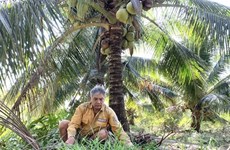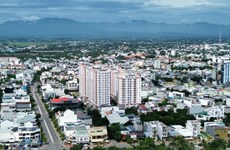Thai imports, falling prices hit Delta farmers
Farmers in the Mekong Delta, the country's largest fruit growing area,
are struggling to sell their produce because local markets are dominated
by Thai imports.
Farmers in the Mekong Delta, the country's largest fruit growing area,
are struggling to sell their produce because local markets are dominated
by Thai imports.
Their plight is worsened by falling prices.
In An Giang province alone, hundreds of tonnes of Thai fruits, including durian, mangosteen, tamarind, mango and langsat, are imported into the province and distributed to markets in the Delta, HCM City and even to the central and northern regions, the Sai Gon Giai Phong (Liberated Sai Gon) newspaper reports.
Tu Tieu, a fruit trader in the province's Tinh Bien Market, said she had signed contracts to import about 7-10 tonnes of Thai fruits from Cambodia per month.
"I sell Thai fruits to other wholesale shops in An Giang and other provinces in the Delta, and also in HCM City ," she said.
The import prices of most Thai fruits were much cheaper than local fruits and traders often doubled or tripled their prices when they distributed them in the Delta.
Tieu also claimed that people preferred imported fruits to local ones.
Thai langsat, tamarind and mangosteen were sold at 30,000 VND (1.5 USD) per kg but consumers still bought them because they were both good looking and delicious, said a wholesale trader at Can Tho city's Ninh Kieu Wharf.
Meanwhile, the prices of several local fruits had decreased as the main harvest season approached, and farmers were unable to find outlets for their produce, the newspaper reported.
Le Quang Tu, who grows rambutan in Vinh Long province's Tra On district, said the fruits in his orchard were ripening, but prices had fallen to 3,000-4,000 VND a kg.
"A few months ago, traders came to my orchard and offered to purchase my rambutan for between 10,000-15,000 VND a kilo," Tu said.
He said a few days ago he had transported his rambutan to Can Tho city and sold them on the street for 6,000 VND a kilo, but was not able to sell all of them.
Meanwhile, the high prices of locally grown speciality fruits like durian, mangosteen and king orange, at 25,000-35,000 VND a kilo, are not finding many consumers.
Nguyen Minh Chau, head of the Southern Fruit Research Institute, said local fruits were not really more expensive than imported ones.
The prices of many local specialty fruits were much higher than imported ones because there were too many layers of traders in the distribution channel from the orchards to ultimate consumers, Chau said.
Under the current distribution network, farmers sell their fruits to local brokers, who sell them to locally based wholesalers, who then sell them to wholesale shops in other localities, from where they get to retail shops and retail traders before reaching consumers.
"With each distribution layer, the prices of local fruits are pushed higher, so when the fruits reach consumers, their prices end up being are high," Chau said./.
Their plight is worsened by falling prices.
In An Giang province alone, hundreds of tonnes of Thai fruits, including durian, mangosteen, tamarind, mango and langsat, are imported into the province and distributed to markets in the Delta, HCM City and even to the central and northern regions, the Sai Gon Giai Phong (Liberated Sai Gon) newspaper reports.
Tu Tieu, a fruit trader in the province's Tinh Bien Market, said she had signed contracts to import about 7-10 tonnes of Thai fruits from Cambodia per month.
"I sell Thai fruits to other wholesale shops in An Giang and other provinces in the Delta, and also in HCM City ," she said.
The import prices of most Thai fruits were much cheaper than local fruits and traders often doubled or tripled their prices when they distributed them in the Delta.
Tieu also claimed that people preferred imported fruits to local ones.
Thai langsat, tamarind and mangosteen were sold at 30,000 VND (1.5 USD) per kg but consumers still bought them because they were both good looking and delicious, said a wholesale trader at Can Tho city's Ninh Kieu Wharf.
Meanwhile, the prices of several local fruits had decreased as the main harvest season approached, and farmers were unable to find outlets for their produce, the newspaper reported.
Le Quang Tu, who grows rambutan in Vinh Long province's Tra On district, said the fruits in his orchard were ripening, but prices had fallen to 3,000-4,000 VND a kg.
"A few months ago, traders came to my orchard and offered to purchase my rambutan for between 10,000-15,000 VND a kilo," Tu said.
He said a few days ago he had transported his rambutan to Can Tho city and sold them on the street for 6,000 VND a kilo, but was not able to sell all of them.
Meanwhile, the high prices of locally grown speciality fruits like durian, mangosteen and king orange, at 25,000-35,000 VND a kilo, are not finding many consumers.
Nguyen Minh Chau, head of the Southern Fruit Research Institute, said local fruits were not really more expensive than imported ones.
The prices of many local specialty fruits were much higher than imported ones because there were too many layers of traders in the distribution channel from the orchards to ultimate consumers, Chau said.
Under the current distribution network, farmers sell their fruits to local brokers, who sell them to locally based wholesalers, who then sell them to wholesale shops in other localities, from where they get to retail shops and retail traders before reaching consumers.
"With each distribution layer, the prices of local fruits are pushed higher, so when the fruits reach consumers, their prices end up being are high," Chau said./.













